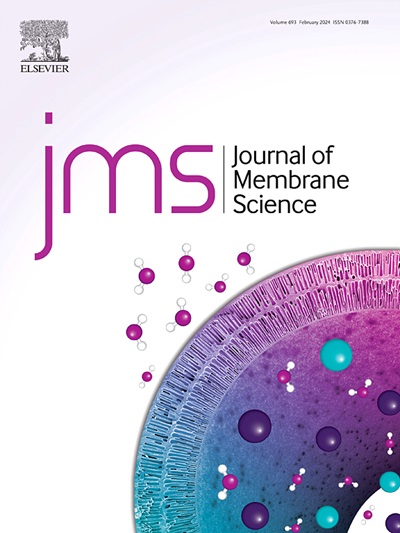Doped-Mn electrospun nanofiber membrane with targeted ozone activation: High-efficiency complete pollutant removal via photocatalytic ozonation during oil-water separation
IF 8.4
1区 工程技术
Q1 ENGINEERING, CHEMICAL
引用次数: 0
Abstract
Membrane processes are confronting the escalating challenge of simultaneously addressing refractory pollutant removal and membrane fouling in the advanced treatment and reuse of petrochemical wastewater. This study introduces Mn-doped carbon nitride nanotubes (CNTMn) into polyacrylonitrile (PAN) nanofiber membrane (MPAN-CNTMn), endowing them with dual functions of efficient oil-water separation and photocatalytic ozonation (COP) self-cleaning activity. MPAN-CNTMn achieves >98 % separation efficiency for dodecane, hexadecane, and n-hexane emulsions. Under COP conditions, MPAN-CNTMn can degrade 95.2 % tetracycline (TC) and 84.4 % p-nitrophenol (PNP) within 60 min. Notably, the MPAN-CNTMn nanofiber membrane exhibits excellent resistance to water quality interference, with secondary treatment flux recovery rates for dodecane-TC, dodecane-PNP mixtures, and crude oil emulsions increased by 22.7 %, 24.9 %, and 19.4 % compared to PAN nanofiber membrane (MPAN). The hydrophilic nano-interface of MPAN-CNTMn nanofiber membrane facilitates efficient mass transfer between pollutants and reactive species. And doped-Mn enhances the directional conversion of free O3 into ∗O and O3•-, which achieve pollutant degradation through a synergistic pathway of "∗O non-radical surface activation & O3•- radical liquid-phase reaction chain transfer". Overall, the proposed COP self-cleaning oil-water separation nanofiber membrane system offers a novel approach for the synergistic resolution of membrane fouling control and pollutant removal in oily wastewater treatment.

定向臭氧活化掺杂锰静电纺纳米纤维膜:油水分离过程中光催化臭氧氧化高效完全去除污染物
在石油化工废水深度处理和回用中,膜工艺面临着同时解决难降解污染物去除和膜污染的挑战。本研究将mn掺杂氮化碳纳米管(CNTMn)引入聚丙烯腈(PAN)纳米纤维膜(MPAN-CNTMn)中,使其具有高效油水分离和光催化臭氧化(COP)自清洁活性的双重功能。MPAN-CNTMn对十二烷、十六烷和正己烷乳液的分离效率达到98%。在COP条件下,MPAN- cntmn可在60 min内降解95.2%的四环素(TC)和84.4%的对硝基酚(PNP)。值得注意的是,MPAN- cntmn纳米纤维膜具有优异的抗水质干扰能力,其对十二烷-TC、十二烷-PNP混合物和原油乳状液的二次处理通量回收率分别比PAN纳米纤维膜(MPAN)提高22.7%、24.9%和19.4%。MPAN-CNTMn纳米纤维膜的亲水性纳米界面促进了污染物和反应物质之间的有效传质。掺杂mn增强了游离O3向* O和O3•-的定向转化,通过“* O非自由基表面活化&”的协同途径实现污染物降解;O3•自由基液相反应链转移”。综上所述,COP自清洁油水分离纳米纤维膜系统为含油废水处理中膜污染控制和污染物去除的协同解决提供了一种新的途径。
本文章由计算机程序翻译,如有差异,请以英文原文为准。
求助全文
约1分钟内获得全文
求助全文
来源期刊

Journal of Membrane Science
工程技术-高分子科学
CiteScore
17.10
自引率
17.90%
发文量
1031
审稿时长
2.5 months
期刊介绍:
The Journal of Membrane Science is a publication that focuses on membrane systems and is aimed at academic and industrial chemists, chemical engineers, materials scientists, and membranologists. It publishes original research and reviews on various aspects of membrane transport, membrane formation/structure, fouling, module/process design, and processes/applications. The journal primarily focuses on the structure, function, and performance of non-biological membranes but also includes papers that relate to biological membranes. The Journal of Membrane Science publishes Full Text Papers, State-of-the-Art Reviews, Letters to the Editor, and Perspectives.
 求助内容:
求助内容: 应助结果提醒方式:
应助结果提醒方式:


